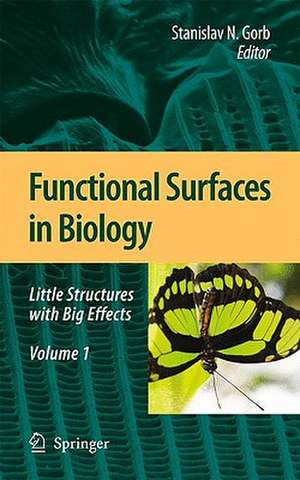Functional Surfaces in Biology
Editat de Stanislav S. N. Gorben Limba Engleză Hardback – 29 oct 2009
Volume 1Functional Surfaces in Biology: Little Structures with Big Effects. This book is devoted to the rapidly growing area of science dealing with structure and properties of biological surfaces in their relation to particular function(s). The issue, written by a team of specialists from different disciplines, covers various surface functions, such as protection, defence, water transport, anti-wetting, self cleaning, light reflection and scattering, and acoustics. Because biological surfaces hide virtually endless potential of technological ideas fordevelopment of new materials and systems, inspirations from biology may be also interesting for a broad range of topics in surface engineering.
Volume 2 Functional Surfaces in Biology: Adhesion Related Phenomena. This book describes structure and properties of biological surfaces with particular adhesive properties. The issue, written by a team of specialists from different disciplines, covers two main types of systems: those specialised in adhesion enhancement or in adhesion reduction. Information on adhesive organs of insects, geckos, barnacles, and fish is given in the first part of the book. The second part considers plant surfaces specialised in the adhesion reduction. Because of the diversity of functions of adhesion-related biological surfaces, inspirations from biology may be also interesting for a broad range of topics in engineering.
Preț: 1034.85 lei
Preț vechi: 1473.93 lei
-30% Nou
Puncte Express: 1552
Preț estimativ în valută:
198.01€ • 206.76$ • 163.52£
198.01€ • 206.76$ • 163.52£
Carte indisponibilă temporar
Doresc să fiu notificat când acest titlu va fi disponibil:
Se trimite...
Preluare comenzi: 021 569.72.76
Specificații
ISBN-13: 9781402099946
ISBN-10: 1402099940
Pagini: 678
Ilustrații: XVIII, 660 p. 2 volume-set.
Dimensiuni: 155 x 235 x 62 mm
Greutate: 1.27 kg
Ediția:2010
Editura: SPRINGER NETHERLANDS
Colecția Springer
Locul publicării:Dordrecht, Netherlands
ISBN-10: 1402099940
Pagini: 678
Ilustrații: XVIII, 660 p. 2 volume-set.
Dimensiuni: 155 x 235 x 62 mm
Greutate: 1.27 kg
Ediția:2010
Editura: SPRINGER NETHERLANDS
Colecția Springer
Locul publicării:Dordrecht, Netherlands
Public țintă
ResearchNotă biografică
Stanislav Gorb is a group leader at the Max Planck Institute for Metals Research in Stuttgart, Germany. He received his PhD degree in zoology and entomology at the Schmalhausen Institute of Zoology of the Ukrainian Academy of Sciences in Kiev. Gorb was a postdoctoral researcher at the University of Vienna, a research assistant at University of Jena, a group leader at the Max Planck Institute for Developmental Biology in Tübingen, and a visiting professor at both the University of Washington and Nanjing University of Astronautics and Aeronautics in China. Gorb’s research focuses on morphology, structure, biomechanics, physiology, and evolution of surface-related functional systems in animals and plants, as well as the development of biologically inspired technological surfaces and systems. He received the Schlossmann Award in Biology and Materials Science in 1995 and was the 1998 BioFuture Competition winner for his works on biological attachment devices as possible sources for biomimetics. Gorb has authored three books, including Attachment Devices of Insect Cuticle and Biological Micro- and Nanotribology; more than 100 papers in peer reviewed journals; and three patents. Gorb can be reached at the Evolutionary Biomaterials Group, Department of Thin Films and Biological Systems, Max Planck Institute for Metals Research, Heisenbergstrasse 3, 70569 Stuttgart, Germany; e-mail s.gorb@mf.mpg.de.
Textul de pe ultima copertă
Functional Surfaces in Biology: Little Structures with Big Effects. This book is devoted to the rapidly growing area of science dealing with structure and properties of biological surfaces in their relation to particular function(s). The issue, written by a team of specialists from different disciplines, covers various surface functions, such as protection, defence, water transport, anti-wetting, self cleaning, light reflection and scattering, and acoustics. Because biological surfaces hide virtually endless potential of technological ideas for development of new materials and systems, inspirations from biology may be also interesting for a broad range of topics in surface engineering.
Functional Surfaces in Biology: Adhesion Related Phenomena. This book describes structure and properties of biological surfaces with particular adhesive properties. The issue, written by a team of specialists from different disciplines, covers two main types of systems: those specialised in adhesion enhancement or in adhesion reduction. Information on adhesive organs of insects, geckos, barnacles, and fish is given in the first part of the book. The second part considers plant surfaces specialised in the adhesion reduction. Because of the diversity of functions of adhesion-related biological surfaces, inspirations from biology may be also interesting for a broad range of topics in engineering.
Functional Surfaces in Biology: Adhesion Related Phenomena. This book describes structure and properties of biological surfaces with particular adhesive properties. The issue, written by a team of specialists from different disciplines, covers two main types of systems: those specialised in adhesion enhancement or in adhesion reduction. Information on adhesive organs of insects, geckos, barnacles, and fish is given in the first part of the book. The second part considers plant surfaces specialised in the adhesion reduction. Because of the diversity of functions of adhesion-related biological surfaces, inspirations from biology may be also interesting for a broad range of topics in engineering.
Caracteristici
New subject not covered in other books to this extent Interdisciplinarity Potentially interesting to biologists Physicists, engineers Richly illustrated
